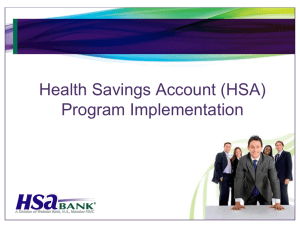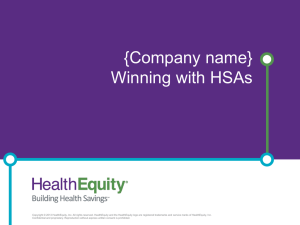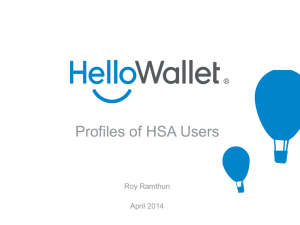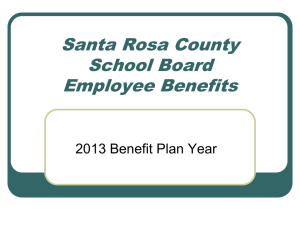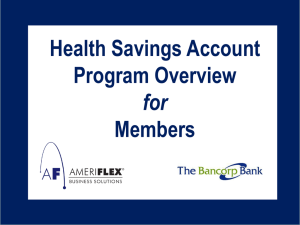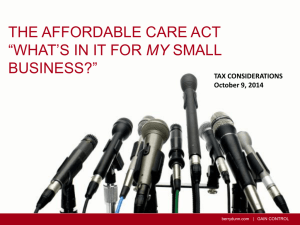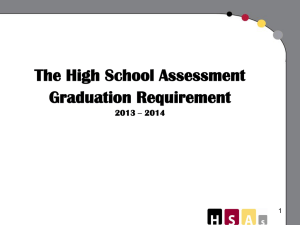October-2014-High-Deductible-Health-Care-Plan-Option
advertisement
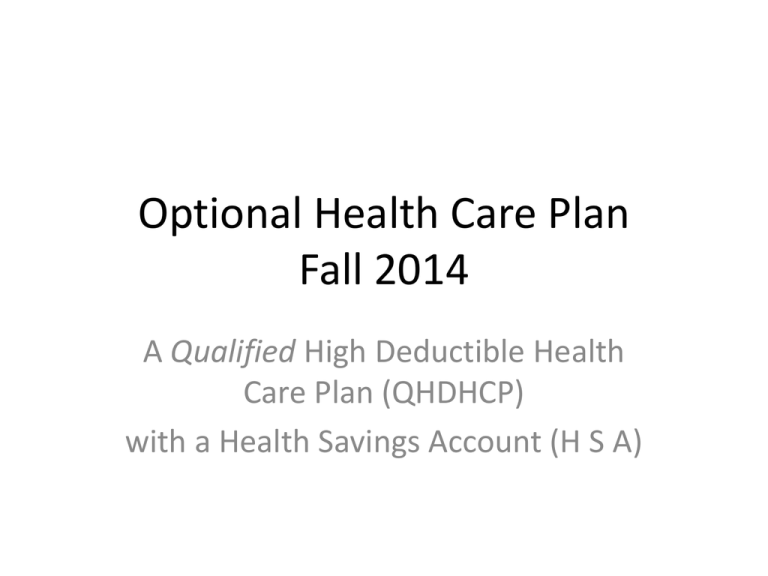
Optional Health Care Plan Fall 2014 A Qualified High Deductible Health Care Plan (QHDHCP) with a Health Savings Account (H S A) High Deductible Health Plans [HDHCP] • Basically two types – Regular plan that simply has a higher deductible – usually means a deductible of $1000 or more – Sometimes fully insured plan will use an HRA to help offset a higher deductible – A Qualified (signified by a Q) plan has an upfront (before any benefits are paid) deductible and is most often offered in conjunction with an HSA What is a QHDHCP? • Must follow the guidelines as laid out by the IRS...to obtain the tax advantages prescribed • Annual Deductible Minimum set by the IRS – $1,250 Individual and $2,500 family (IRS) • Solanco Plan: A $2,000 Individual and $4,000 Family plan design Qualified High Deductible Health Plan (QHDHP) • QHDHPs generally have: – First dollar coverage (no deductible) for preventive care – Higher out-of-pocket (copays & coinsurance) for non-network services • All covered benefits must apply to the plan deductible, including prescription drugs Kaiser Health Benefits Survey 2014 25,000 Solanco PPO Plan Tiers: Annual Rate Employer 19,700 20,000 Employee 13,649 15,000 10,000 Employer + 1 Employee +1 8,443 Employer Family 5,000 507 955 - 2014-15 1,576 Employee Family HDHCP Plan Design & Pricing: Rates for 2014-15 PPO and 2015 H S A HDHCP Employer PPO Employer + 1 PPO Employer Family PPO 8,443 13,649 19,700 Employer HDHCP Employer +1 HDHCP Employer Family HDHCP 6,417 10,373 14,972 2,026 3,276 4,728 H S A Objective: Front Load Employee Account; Create Opportunity to Build up Bank Balance; Maintain Quality Health Care Contibutions to H S A Employee only Tier Employee* Total To H S A 2014 Max** 2015 Max** District Yr 1 District Yr 2 District Yr 3 1,600 1,500 1,250 500 500 500 2,100 2,000 1,750 3,300 3,350 District Yr 1 District Yr 2 District Yr 3 Family Tier 3,200 3,000 2,500 Employee* 1,000 1,000 1,000 4,200 4,000 3,500 6,550 6,650 * Employee = Employee share is the required amount, it is from Premium Share the Employee is paying as per the CBA. These funds are collected by the district and returned to the Employee H S A account. **Maximum Excludes additional $1,000 an Employee can contribute in the year turning age 55 or if age 55 or older. H S A Bank Account Employee A Employee B (Contributes 2015 Maxium) Annual Use/Spend 1,600 1,500 1,250 500 500 500 1,750 1,850 2,100 1,000 1,100 1,200 1,100 900 550 2,350 2,250 2,150 Totals 4,350 Total 3 yr Employer and Employee amounts at Min and Max 1,500 5,700 3,300 2,550 6,750 5,850 10,050 Employee A Employee B (Contributes 2015 Maxium) Annual Use/Spend Employee H S A Bank Account Year 1 Year 2 Year 3 Employee( Family) H S A Bank Account Employer Employer Total A (Employer Plus Emp A less spend) Total A (Employer Plus Emp A less spend) Total B (Employer plus Emp B less spend) Total B (Employer plus Emp B less spend) Year 1 Year 2 Year 3 3,200 3,000 2,500 1,000 1,000 1,000 3,450 3,650 4,150 2,000 2,200 2,400 2,200 1,800 1,100 4,650 4,450 4,250 Totals 8,700 3,000 11,250 6,600 5,100 13,350 Total 3 yr Employer and Employee amounts at Min and Max 11,700 19,950 Your Money: To your own Bank Account Employee H S A Bank Account Year 1 Year 2 Year 3 Employee( Family) H S A Bank Account Year 1 Year 2 Year 3 Employee A 500 500 500 Employee A 1,000 1,000 1,000 Emp A per pay ( 24 pays) 20.83 20.83 20.83 Emp A per pay ( 24 pays) 41.67 41.67 41.67 Employee B (Contributes Emp B per Min Less 2015 pay (24 pays) Optional Max Maxium) 1,750 72.92 52.08 1,850 77.08 56.25 2,100 87.50 66.67 Employee B (Contributes Emp B per Min Less 2015 pay (24 pays) Optional Max Maxium) 3,450 143.75 102.08 3,650 152.08 110.42 4,150 172.92 131.25 HSA Overview • A Health Savings Account (HSA) is a special account owned by an individual used to pay for current and future medical expenses • HSAs are used in conjunction with a Qualified High-Deductible Health Plan (QHDHP) • Insurance that does not cover first dollar medical expenses (except for preventive care) • Can be an HMO, PPO or indemnity plan, as long as it meets the requirements • A QHDHP can be offered by a group as an option along with other type plans OR can be a stand alone offering What is an H S A? • An employee owned account • Contributions can come from Employee (EE) or Employer – – – – – – Employer Contribution EE Pre-tax via payroll EE After tax contribution (out side of payroll) EE Gifts EE IRA transfer - 1 one per lifetime tax free IRS annual maximum ( For 2013, 2014 & 2015) • Individual 2015 = $3,350 (2014 $3,300) (2013 $3,250) • Family 2015 = $6,650 (2014 $6,550) (2013 $6,450) • $1,000 per year catch-up provisions – age 55+ end of tax year. What is an H S A? (2) • As an employee owned account, funds are rolled over every year, not taxed on interest earned or when funds are used (i.e. used with in IRS guidelines). Taxed as income with a 20% penalty if funds are used for non-medical expenses • Contributions can be made generally up to April 15th ( tax return time) for the prior year….IRS rules governing contributions IRS Reporting W-2 • Participants of Solanco School District’s High Deductible Health Plan (HDHP) are required to complete IRS Form 8889 - HEALTH SAVINGS ACCOUNTS (HSA) with their annual federal income tax filing to comply with Internal Revenue Service requirements. Employee and employer contributions to a HSA and distributions from a HSA during the calendar year must be reported on Form 8889. • What information must be reported? • Solanco School District’s W-2 forms report the total amount of contributions forwarded to the employee’s HSA, by the school district, during the calendar year. Total contributions forwarded to the employee’s HSA are reported in box 12, preceded with the code ‘W’. HSA contributions deducted from the employee’s payroll and HSA contributions provided by the employer for the benefit of the employee are combined and reported in box 12. IRS Reporting 1099 • How do I report distributions from my HSA for federal income tax purposes? • The employee (owner of HSA) should receive an IRS Form 1099-SA from Health Equity (HSA administrator) with the total amount distributed from the HSA during the calendar year reported in box 1 (Gross Distribution). Report this amount on Line 14a, Part II of IRS Form 8889. Complete additional lines of Part II, as applicable. Qualified High-Deductible Health Plan (QHDHP) • Preventive Care – PPACA guidance provides list of preventive care that QHDHP may provide as first-dollar coverage before minimum deductible is satisfied: • • • • • • Periodic health evaluations (e.g., annual physicals) Screening services (e.g., mammograms) Routine pre-natal and well-child care Child and adult immunizations Tobacco cessation programs Obesity weight loss programs HSA Contribution Rules • Contributions to HSA can be made by the employer or the individual, or both. – If made by the employer, it is not taxable to the employee (excluded from income and wages) – If made by the individual, it is an “above-the-line” deduction – The maximum amount that can be contributed to an HSA from all sources • $3,350 (self-only coverage) 2015 • $6,650 (family coverage) for 2015 [includes working spouses if both H S A eligible] HSA Contribution Rules: Employee Contributions • Can be made by a salary reduction arrangement through a cafeteria plan (section 125 plan amendment) – Elections to make contributions through a cafeteria plan can change on a month-bymonth basis (unlike salary reduction contributions to an FSA) – Remember that contributions to the HSA through a cafeteria plan are “pretax” and not subject to individual or employment taxes Member Portal www.myhealthequity.com Prepopulated With Your Claims View and Pay Claims Online HSA How To Doctors Visits 1 Go to the doctor No co-pays 2 Doctor sends insurance carrier the bill HealthAmerica adjusts price based on discounts 3 Claim integrated into member portal Pay doctor from HSA funds, if funds are available. Pay out of pocket if funds aren’t available and reimburse yourself later. *This card is issued by The Bancorp Bank pursuant to a license from Visa U.S.A. Inc. The Bancorp Bank; Member FDIC. Member HSA Experience Integrated Medical Claims If deductible has not been met, provider will bill member for their plan negotiated portion. Member goes to Doctor, shows HealthAmerica card Doctor sends visit details and coding to HealthAmerica for claims adjudication HealthAmerica sends claims to HealthEquity for record keeping and member portal population daily If deductible has been met, plan will pay provider for service. If member owes coinsurance, provider will bill member for their portion. daily Member pays outstanding provider bill using funds on HSA card or personal funds through member portal daily When the member has claim activity, an EOB from HealthAmerica is sent for each claim. Claim information and monthly statements on HSA funds and account information is available on HealthEquity portal. HSA How To Pharmacy Prescriptions 1 Go to pharmacy Show your HealthAmerica card 2 Pharmacy applies discount Pay with your HSA card 3 Pharmacy sends claim to insurance carrier Insurance carrier applies amount to your deductible— no paperwork needed *This card is issued by The Bancorp Bank pursuant to a license from Visa U.S.A. Inc. The Bancorp Bank; Member FDIC. HSA Member Experience Pharmacy Claims Member goes to Pharmacy and shows HealthAmerica card daily Pharmacy verifies eligibility. If out of pocket max is not met, member can pay using HSA card or out of pocket. immediate Pharmacy and HSA card send payment information to Health America and HealthEquity for record keeping and account tracking. daily When the member has claim activity, they will receive an EOB from HealthAmerica for each claim. Claim information and monthly statements on HRA funds and account information is available on each member’s HealthEquity portal. Member Services HealthEquity Member Services is available everyday, 24/7/265 at 866.855.4066 Building Health SavingsSM through Live Service 24/7/365 Personalized Savings Strategies Account Integration HSA Accounts • No “use it or lose it” rules like Flexible Spending Arrangements (FSAs) – All amounts in the HSA are fully vested – Unspent balances in accounts remain in the account until spent and carry over year-to-year – Encourages account holders to spend their funds more effectively on their medical care – Encourages account holders to shop for the best value for their health care dollars • Accounts can grow through investment earnings, just like an IRA – Same investment options and investment limitations as IRAs H S A: Board and Employee Contribution Mix and Shares Proposed District and Employee Contribution to Optional H S A QHDHCP Coverage Tier District H S A Contribution Minimum Employee premium share Total Minimum HSA Entry Year Single Family $ $ 1,600 $ 3,200 $ 500 $ 1,000 $ 2,100 Year One 4,200 Single Family $ $ 1,500 $ 3,000 $ 500 $ 1,000 $ 2,000 4,000 Year Two Single Family $ $ 1,250 $ 2,500 $ 500 $ 1,000 $ 1,750 3,500 Year Three Eligibility & Funding • For January 1: – Full-time active staff currently enrolled in the District Health Care ( e.g. LTS’s not eligible) – Retirees eligible • Presently have a $1,200 deductible plan option & now the Q plan • Eligible employees hired (start date) after April 1 of each year not eligible for QHDHCP until following January (via Fall enrollment) • Year one : 100% board share in January • Successive years 65% in January and 35% in September Deposits to Health Equity Bank Account..... • Year one: 100% of Board Contribution made in January – 2015 “Class” January 2015 = $1,600 or $3,200 • Successive years: 65% in January --& 35% in See Separate Hand out sheet • Employee Payroll Contributions – After Each Payroll [No less than Monthly] • E-mail notifications from Health Equity----Funds in and out. Timelines / Schedule • October Presentations • PPO 60 day PPACA notice and Summary of Benefit & Coverage (SBC’s)issuance • October 29; Central Office; meeting and employee Q & A • November 14 Enrollment deadline – Time to Set up Accounts; Payroll deduction set-up: both mandatory and optional entry; Funding alignment; WEB site set-up and on-line tools • New ID Cards---January 1st start (Not just H S A) For January 1, 2015 • Choose the ‘Q ‘plan with H S A (Options on H S A $ amounts, No FSA) • Stay with H S A Plan.....Leave H S A Plan • Stay with the current PPO plan (FSA option, no H S A) • Spousal Rule certifications – Everyone; H S A context – Surcharge is $1,627.92 for 2015 – [E + 1 Rate of $13,649.28 x 12%] • Dual Coverage issues impact H S A selections ( i.e. you are “covered” by your spouses plan too) Deductibles and Co-pay Changes Hospitalization Data for 2014-15 Current PPO Plan Jan 2015 QHDHP Participating Provider Non-Participating Provider Participating Provider Non-Participating Provider Individual $200 $400 $2,000 $4,000 Family $600 $1,200 $4,000 $8,000 $35.00 80% after deductible $15.00 20% after deductible $25.00 20% after deductible $25.00 $25.00 $15.00 20% after deductible $25.00 20% after deductible Deductible Co-Pays Office Visit (PCP) Office Visit (Specialist) $45.00 Urgent Care Center $35.00 80% after deductible 80% after deductible $25.00 80% after deductible $35.00 80% after deductible Chiropractic Mental Health - Outpatient Additional Resources • District web site under Business office Department – www.solanco.org – Go to Departments, and then the Business Office page • Health Equity web site below: – www.healthequity.com/hsalearn
